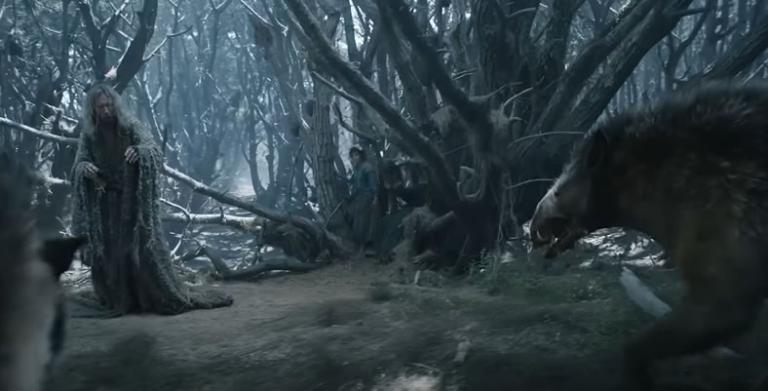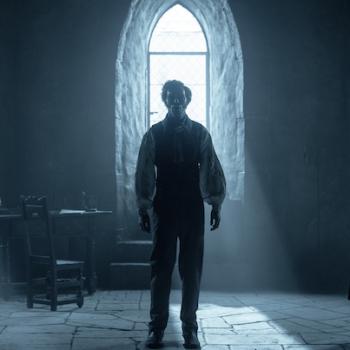
Amazon’s Prime Video is set to trot out its lavish series, Lord of the Rings: The Rings of Power this Friday. Amazon reportedly spent $465 million on the eight-episode series (making it the most expensive television show ever), and it looks it.
The show’s not entirely true to J.R.R. Tolkien, from what I gather. It takes place in Middle Earth’s 3,000-year-long Second Age (The Lord of the Rings trilogy takes place in the Third), and most characters the casual Tolkien fan might know haven’t been born. But Galadriel, the future queen of Lothlorien, is here—a fearsome warrior in these early days, apparently—as is a young, honey-tongued Elrond. And we meet a bevy of new characters, many who Tolkien never mentioned.
But if Amazon took a few liberties with Tolkien’s Second Age, it seems to be preserving its overall spirit. And that’s important, because Tolkien’s Middle Earth is undergirded by his faith. He himself called The Lord of the Rings a “fundamentally religious and Catholic work,” and The Rings of Power shows that it will embrace some of those same elements. This is, after all, a story about good and evil, and the nature of them both.
The actual Rings of Power haven’t been crafted yet as the story begins. But we meet their chief architect, the elf-smith Celebrimbor (played by Charles Edwards), who has ambitions of creating a massive forge that might help him create things of “real power.” He’s got the best intentions in mind, and the Gil-galad, the elf king (Benjamin Walker), loans him Elrond to make it happen.
Sauron, meanwhile, is lurking in the shadows. But the show begins, he’s thought to be more of a half-remembered bogeyman than a real threat. As the show opens, it’s been a long time since anyone’s seen even an orc, much less the Big Bad himself, and most folks assume that Sauron’s no more. Galadriel (Morfydd Clark) is not so easily convinced, though—especially when she sees a symbol associated with the guy in Middle Earth’s most northerly realms.
“Evil does not sleep, Elrond,” Galadriel says in the opening episode. “It waits.”

Hiding In the Shadows
If the show follows Tolkien, Sauron will reappear—but in disguise. He’ll get chummy with Celebrimbor and help him make the rings, then run off in secret to forge the one ring to rule them all. But for now, he’s simply an unseen hand, waiting to tug on the strings of Middle Earth’s marionette.
Evil—in Tolkien’s world and in ours—is sly. It’s sneaky. Sure, sometimes it comes at you headlong, when it feels like its strong enough, as we saw in the climactic battles of The Lord of the Rings. But before it reveals itself for what it is, it hides. It hid in Saruman, Middle Earth’s wise head wizard with a voice that could charm almost anyone. It hid in Grima Wormtongue, who whispered untruths and half-truths in the ear of Theoden, king of Rohan. Evil comes as a pretty face and a trusted voice, using our hopes and our fears against us. And the Bible warned us all about it.
“And no wonder, for even Satan disguises himself as an angel of light,” Paul wrote in 2 Corinthians 11:14-15. “So it is no surprise if his servants, also, disguise themselves as servants of righteousness.”
Tolkien rejected the idea that his works were allegorical: There’s easy-to-trace symbolism between myth and faith of the sort you find in The Chronicles of Narnia, written by Tolkien’s friend C.S. Lewis. But Middle Earth contains myriad Christian echoes. And perhaps the most important in the Second Age is just how evil works in that world—and in ours. Through corruption.

The Rot in Middle Earth
Christianity does not embrace the idea that good and evil are equally weighted forces in constant battle with each. God is at the top of the cosmic pyramid, Creator of everything, and He is absolutely good—without blemish. Evil came about through rebellion, we’re told: Lucifer rejected the Lord’s lordship and went his own way, taking a bunch of angels with him.
That’s what happens in Tolkien’s world, too. Without getting too deep in the weeds, Sauron is, in a sense, a fallen angel himself—one of the Maiar in Tolkien’s words. He was beautiful to look at (at least before his corporal form was taken from him), and he was a pretty OK guy before he was corrupted.
“Nothing is evil in the beginning,” Elrond says in The Fellowship of the Ring. “Even Sauron was not so.”
When you look at the broad history of Middle Earth (and even the island of Numenor, which sank into the sea after its people were corrupted) is the story of beautiful things being broken—by pride, by greed, by sloth. And, of course, by the one ring, a corruptive power that Elrond saw first-hand. It made him loathe to hide or use the ring, knowing that even he could be corrupted.
Even looking at a map of Middle-Earth reveals that corruption at work. Minas Morgol, stronghold of the dreaded Nazgul, was once the beautiful Minas Ithil. The dark forest Mirkwood was once upon a time known as Greenwood the Great before Sauron turned his eye toward it. And in The Rings of Power, we see the land that will eventually become Sauron’s stronghold of Mordor is filled with fields, tended by farmers and ranchers.
The great theologian Augustine said that evil can’t create: It can only corrupt. It’s the rot in the peach, the termites in the wood, the hole in the road. And if left unchecked, it ultimately eats away everything. Even our biggest sins are corruption of God’s gifts.
And, as Galadriel might tell us, it begins its work unnoticed.
We see that evil in The Rings of Power beginning its corruptive work. Orcs are digging tunnels unseen—underneath the very floorboards of people. It works through an artifact—emblazoned with Sauron’s sigil—as it enchants a teen boy. It may even work through the seeming complacency of Middle Earth’s staunchest defenders. Only Galadriel seems convinced that Sauron’s still out there. Only she, and a handful of others, seem still vigilant. That’s important, because complacency allows that corruption to take hold.
And maybe that’s a lesson we’d do well to remember ourselves.













